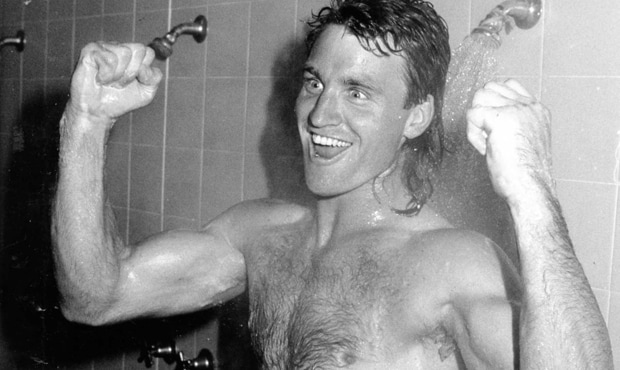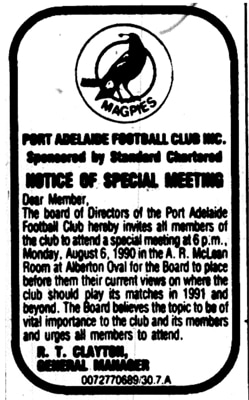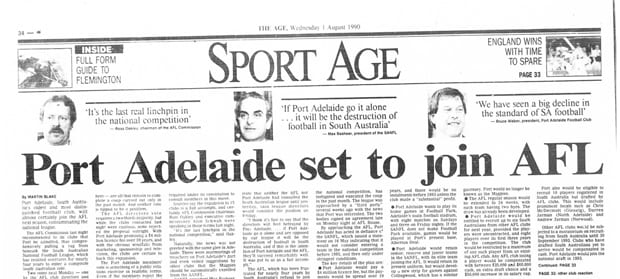It’s been 25 years since Port Adelaide changed football forever…
Sunday 29 July 1990, was a Sunday like most others in Adelaide.
The sun came up, mum and dad ate breakfast, kids went to play footy.
Uni students slept in.
Port Adelaide had won the day before - three in a row, this time by 62 points over West Torrens.
Despite the rain, it smelled like another premiership year.
The paper was delivered on concrete driveways around the city, telling readers as much.
Over the border, in Victoria, it was a similar situation. St Kilda had won by 75 over the Swans, everyone was gearing up for Hawk Michael Tuck's 400th against the Bears.
But in their paper, news had broken that would fundamentally shift Australian Football from that day on.
Port Adelaide, it had been revealed, was in secret negotiations with the AFL to join the national competition for the 1991 season, as the first team for South Australia, and the only pre-existing club from outside Victoria.
It was news that would shake South Australian football to the core...
The build up
For almost a decade prior Port Adelaide, like many other South Australian clubs, had lost some of its best talent to the VFL.
For the Magpies, names like Mark and Stephen Williams, Bruce Abernethy, Greg Phillips, Martin Leslie, Greg Anderson and Craig Bradley had all been lured to the cashed-up VFL competition.
The need to pay exorbitant sums to retain players, above the day-to-day costs of running a club, was crippling many in South Australia, but even though the VFL approached the SANFL to enter a composite side in the late 80s, the decision was made in Adelaide, and ratified again in May 1990, to hold off until at least 1993.
Amid the backdrop of the first half of 1990, Port Adelaide, fresh from vanquishing North Adelaide in the 1989 grand final, hosted Geelong in a pre-season trial game at Football Park.
There, before an official crowd of 27,743, a talent-laced Cats beat the Magpies by 52 points with a side featuring legendary Gary Ablett senior, and current Port Adelaide SANFL coach Garry Hocking.
What the figure doesn’t indicate is the actual crowd size.
Many punters desperate to see an AFL club in action against South Australia’s champions were stuck in the turnstiles for much of the first quarter, so instead elected to jump the fences to get into Football Park.
Whether it was the verbal crowd of 30-35,000, or the official figure, the crowd was at least bigger than all but four of the 142 SANFL-sanction games, including finals, held in 1989.
With a taste of the future national competition, Port Adelaide began to negotiate with the league.

That winning feeling (again)...Scott Hodges booted four goals in Port Adelaide's 1989 thumping of North. The stage was set for a big 1990...
Sunday – the news breaks
On the same weekend that Michael Tuck played his 400th VFL/AFL game, heads from AFL House and Alberton met to continue their discussions. But the jig was up and a wily journo had the story.
Mike Sheahan broke the news on the front page of the Sunday Age paper.
_620.jpg)
“The Australian Football League and rebel South Australian football officials are at an advanced stage in secret negotiations that would see an Adelaide-based 15th team in the national competition next year," Sheahan wrote.
"Top-level discussions between AFL officials and SA representatives are believed to have been proceeding steadily for several weeks. This is in defiance of the South Australian [National] Football League’s official declaration in May that there would be no SA team in the AFL until 1993 at the earliest.
"It is believed the South Australian push to join the national league is centred on the involvement of the state’s most famous club, Port Adelaide – the local equivalent of Collingwood.”
Norwood was also named as the second team to have engaged in discussions. This was confirmed in later years, and in then AFL chief executive Ross Oakley's recent memoirs.
What was clear was that Port Adelaide was strongly linked. Anecdotally, Sheahan had seen Port officials in meetings at AFL House, and broken the story.
Everyone waited with bated breath to see the next move...
Monday – the plot thickens
By Monday morning, news had filtered through to Adelaide, with an article published in The Advertiser the next day that two clubs, one potentially Port Adelaide, had been linked to a move into the AFL.
While Port Adelaide still hadn’t been confirmed as the club in talks at AFL House, the link was clearly strong.
A notice calling for a Special General Meeting in early August published by the club in the paper that day only added to the speculation.

There was certainly something going on at Alberton.
AFL Chairman Alan Schwab had admitted the previous Thursday at a West Torrens Football Club function that his league was in negotiations with other parties.
Everyone just wanted to know for sure.
Tuesday – It's Port!
This was the day that changed football in South Australia forever.
Day One of the bitter hatred of Port Adelaide.
Whether it was the assertion of innovative foresight hunting the future on the one side of the coin (Port Adelaide) or the accusation of traitorous self-interest on the one sight of the coin (not Port Adelaide), the world was left in little doubt.
When it came to the AFL, Port Adelaide wanted in and it had the power to do so.
Changes to the Port Adelaide constitution had made it possible for the club to unilaterally enter agreement with the AFL to join, even without membership approval.
Among other things, it emerged that Port Adelaide had, at one point discussed with North Melbourne the potential of buying that club’s VFL licence, and that the club’s constitution allowed for private ownership, which may have proved useful in covering the $4 million licence fee demanded by the AFL.
While South Australia scrambled to understand what Port Adelaide bid meant, a cool Victorian press sat back to watch it all play out.
In Melbourne on the Tuesday, the headlines were more forward, somewhat premature and ultimately, many years later, prophetic:



